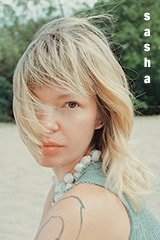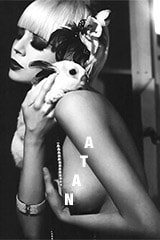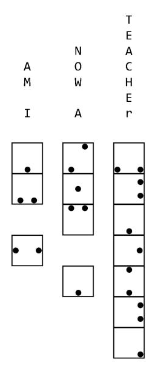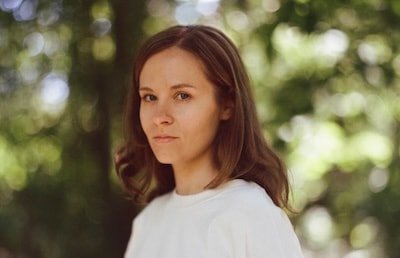Hayley Eichenbaum on Going Viral, Being Instagram-Famous, and How Photography Almost Saved Her
story by Deborah Shapiro
The romance of the American road has a lot to do with renewal, how to take what’s fallen into cliché and make it alive again. This is just what Hayley Eichenbaum has done in several photographic series — going on road trips to capture and create images that reframe the familiar as unearthly and surreal. Her work is guided by the geometry and clean lines of minimalist architecture and design, revealing a mysteriousness beneath flat facades and surfaces. But her pictures are also cinematic, echoing everything from Technicolor melodramas to Two-Lane Blacktop, while Eichenbaum specifically cites sci-fi films of the 1960s and Stanley Kubrick’s work as influential. Her method seems to be a mix of intentionality and spontaneity — literally knowing where she wants to go but allowing for unexpected stops, which she jokes makes her “the worst person to drive with.” But in a more figurative sense, for an interdisciplinary artist without much formal training in photography, that balance of calculation and accident is something of a thread running through her process and her life.
As a teenager in Milwaukee, Eichenbaum was getting together a portfolio to apply to art school. “I’d jammed the back of my car with everything I had ever made in preparation for documentation the following day. I parked outside of my dad’s home for the night, and came down in the morning to find my car robbed clean. Everything was stolen: Every drawing, every painting.” It turned out to be for the best, though. “My portfolio was chock-full of uptight still-life paintings. It lacked any conceptual substance” and the loss of it left her open to begin experimenting with sculpture, kinetic installation, video, live performance, and photography. She discovered she “was a strong metaphorical thinker, which helped translate concept into concrete projects,” and in 2007, she went off to the San Francisco Art Institute. “I would have never gotten in with the portfolio that was stolen.” She eventually transferred to the Milwaukee Institute of Art & Design and after graduating in 2013, stayed in the city, working at The Pitch Project, an artist-run brewery/gallery/collective of studios “created and comprised of some of my greatest mentors and friends.”
Despite the supportive environment, her restlessness led her to plan a month-long, solo road trip along Route 66. It would be the first of many drives she’s since taken on the historic highway that begins in Chicago and ends at the Santa Monica Pier. The first time she arrived in Los Angeles, she had a “visceral reaction” — a mix of “fear and affection” and promised herself she’d move there by the end of 2015, which she did. It’s been a good base for her travels and she was in-between places when we reached her over email to find out how she makes the captivating images that have garnered her a devoted Instagram following, what obsesses her, where she’s been, and where she’s heading.

How would you say your process has evolved over the last few years?
It has changed drastically. When I transferred to MIAD, I decided to declare a major in Illustration. It seemed more practical. I operated within the design department for a long time before my affair with conceptual and 3D work crept back. I ended up majoring in Integrated Studio Arts with a focus in sculpture and performance, and a minor in Illustration. I really find joy in mixing disciplines and exploring the boundary between fine art and design. Some may say it’s a fear of commitment. I like to think of it as an “open relationship” with my mediums.
After graduation, I began taking photos of my travels. The work began to generate a lot of interest, to my complete surprise. Despite feeling more comfortable describing myself as an installation-based performer, I have now found myself taking on the role of digital photographer. I’m still learning the ins and outs of this tool, every day.
What prompted your Route 66 trip and other road trips? Is there something about the road trip — this kind of classic American journey — that interests you?
Initially, it was about therapy. I battle acute anxiety and panic disorder, and being on the road helps confront that struggle. At the risk of sounding cliché, it’s the closest I feel to being free, so, in a way, it has certainly become about that romantic American journey. I have now completed Route 66 eight times. I have explored it so extensively, and as my roots in LA are growing, I feel I’m close to wrapping up The Mother Road series. That being said, I don’t think I’ll ever stop photographing the open road.



How do you recognize the shot when you see it? What draws you to a particular image? Light, color, subject matter?
The first thing I’m attracted to is color, and secondly, architectural geometry. I just may be the worst person to drive with (hence the solo road trips). I’m constantly pulling over to capture an image. In an attempt to be a bit safer, I do a lot of research into the locations I travel to, down to weather reports. Weather (sky-scape) has always played an important role in my compositions.
What do you shoot with?
A Nikon D7100 with a 30mm lens and an 18-240mm lens. Occasionally, I reach for my old Panasonic Lumix; I like how that camera captures movement.
You often manipulate and edit your images after you shoot. Do you tend to know what you want to do with an image as you’re shooting or does that come later?
I don’t think I ever really know in the moment what the post-production plan is; you just follow your gut. But I have one rule: Clean it up. Take out the distractions. All images are genuine moments, with the visual clutter removed (such as excessive power-lines, garbage, etc.) that does not contribute to my final vision. I see color and shape first. When I upload the images, I begin to edit out what I perceive as disorder. This helps achieve the minimal, yet surreal aura. And I pump up and edit already existing colors to match skylines or other surroundings. That color is crucial to my final vision, and I have no shame in heightening what is already there. If a hue doesn’t translate well through the camera, I will make sure to bring it forward in the editing process.



Your earlier work has kind of a staged quality, like you created intentional compositions in order to explore certain themes, especially relating to women and their social roles and sexuality. Your more recent work — like The Mother Road series and the images you’ve recently been posting on Instagram — still has that very deliberate quality but the emphasis seems more strongly on a sense of place, whether it’s real or imagined/heightened. Does it feel like a departure to you?
I absolutely agree. It outwardly seems like a complete departure. My photography began with an interest in capturing kitsch and the idea of colorful, yet, disintegrating façades: The preservation of romance.
I take great pride in Pilot, [from 2013] which was my BFA thesis. To date, it is the most complex project I have ever taken on. I’d spent almost three years learning how to incorporate electromagnetic levitation into my performances. I was interested in the act of floating because of its conceptual associations to reverence, or holiness. And the ideas of “floatation,” “lightness,” and “rotation” are often associated with stereotypical behavior of women. I first reached out to an engineer named Guy Marsden, who had patented a top-levitation device. I utilized his design to complete my project, Attack! The appliance levitates a tube of lipstick upside-down, while paired with an image from a 1969 sex education film. When the lipstick is suspended, it looks phallic, and, also, very much like a bullet. The screenshot from the film was an image of a woman pressing her lipstick into the eye of a man as a defense mechanism.
This study led to the beginning of Pilot. I reached out to a company called Fascinations Inc., which produced bottom-levitation devices. Master carpenter and designer Adam Waite and I embedded nine of these devices within a vanity set, which we made with plywood coated in a high-gloss lacquer. Nine cosmetic objects levitated and rotated during a four-hour performance. The objects only levitate in a sweet spot. If they are not operating in that very sensitive area, they snap down with great force. It all references the clichéd female. I was attempting to keep up with the objects, as I compulsively did my make-up. It was painfully repetitive, leading to a very visible sadness at times. I wanted to pose the question, “Who is in control of the feminine journey?”
During that time, my conceptual practice revolved around breaking down western feminine ideals. I’m still working with these notions in some unreleased projects, while trying to relate it back to the idea of “the façade” that dominates my photographic work. I focus more on place and environment lately. Settle Down concentrates on environment and pattern, with myself playing a faceless, restless character. Those images are taken by my collaborator Zachary Swearingen. With my performance-based installations, such as Pilot, I aim to create a hyper-surreal space in hopes of activating it with conceptual gestures. Within my photographic practice, I hope to capture that hyper-surreal quality while still focusing on telling a story. The act of driving to these locations has a performative quality as well, and the images act as documentation.

There’s a such a sense of mystery to your images and they strike me as rather narrative, like they’re each telling some kind of story. That’s something you’re going for?
It is a definite goal. Especially with a background in illustration, storytelling is germane to every project. And with a platform like Instagram, one has an opportunity to post their images in a specific order. I enjoy that curatorial aspect and, thus, the story that evolves over time.
You’ve got an amazing Instagram account. How has social media, especially Instagram, influenced your photographic practice?
I appreciate that. Social media has completely shaped my career. Without IG I wouldn’t even have a photographic practice. I wouldn’t have been offered the commercial jobs I have worked on over the last four years if it weren’t for the power of social media. Essentially I went from sculptor/performer to photographer in a matter of months. I still have a hard time accepting the title of “photographer,” but perhaps I will warm up to it. It still seems foreign and I wish not to offend those who have trained their whole lives mastering the medium.
It is pretty unreal to experience the phenomenon of going viral. It’s confusing. It’s exciting. It’s nerve-wracking. No one prepares you for that kind of attention. It’s one thing to prepare for, or to be nervous for, an in-class critique or gallery show. It’s another thing to be nervous about people all over the world critiquing your work. But in the end, all I have is gratitude. I’m thrilled to be able to reach and connect with people I have never met.
Whose work do you admire? Are there photographic influences you draw on or would you say your inspiration tends to come from other, non-photographic sources?
I’ve always been attracted to science fiction films of the 1960s: the punchy colors, exaggerated shapes, and sense of symmetry and balance. On that note, I have to mention Stanley Kubrick. His work is calculated and groundbreaking. I have been heavily inspired by multimedia artists Pipilotti Rist, Isabella Rossellini, Melanie Manchot, and Olafur Eliasson. In terms of photography, Stephen Shore and William Eggleston are immediate influences. Yet as of late, I look more to my fellow Instagrammers for inspiration: Sinziana Velicescu (@casualtimetravel), Michelle Gropskof (@dailystreet), Tekla Severin (@teklan), Petra Collins (@petrafcollins), Aleia Murawski (@aleia._), George Byrne (@george_byrne), and Efi Gousi (@efi_gousi). I could go on forever; the list is vast and always growing.
What are your work days like? Do you have a typical work day?
When I’m not on the road, a typical workday consists of editing images and writing/researching for new projects. I also have worked in the service industry since I was young to help finance my practice. I’m currently focusing on reopening my online shop in order to sell prints.
What’s currently obsessing you, in relation to your art? Are there themes, places, or ideas you find you keep returning to?
Coming back to the idea of the façade, New Mexico knows how to stay “pretty.” It’s a place where deterioration and romance coexist. It’s brimming with rich colors and patterns. It’s a place that feels otherworldly at times, a quality that lends itself to my investigations into the surreal. I find it heartening how even the smallest towns are preserved with such care. I think what it comes down to is that I wish to go back in time. A trip through the American South West is one way to feel like you’re avoiding the forward nature of time.
At the risk of drawing you back into that forward nature of time (sorry!), what are you working on now and what’s next for you?
I am still heavily invested in my collaborative duo Settle Down. Zachary Swearingen and I began our collaboration a little over a year ago, and just completed a three-day shoot at The Madonna Inn, in San Luis Obispo. Those images have yet to be released.
I have a show at the end of February in Silver Lake at a gallery called Dust Muffin. I will be exhibiting and selling my prints through March. Beyond that, I look forward to refocusing my energy on installation and performance-based work. I plan to apply for grad school within the next two years. And of course, there are a few road trips in my near future.


via sightunseen.com










